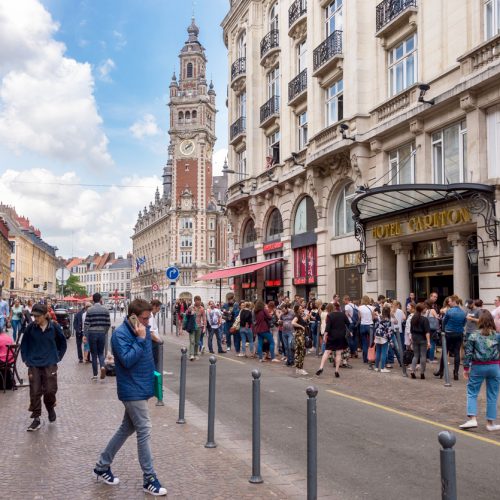Context and policy overview
Da Nang, the economic and transport hub of central Vietnam, is flooded numerous times a year due to its geographical characteristics. It is easily overwhelmed during the heavy rainfall of the typhoon and monsoon seasons and climate change has increased the frequency of floods. Prior to 1998, flash floods occurred once every 10 years. From 1998 to 2009, there were six flash floods, all of them higher than flood warning level 3, the country’s most severe alert level. One deluge almost reached the levels of the historic floods of 1964.[1]
The damage wrought by floods has been worsened by urban sprawl. Flood plains have been developed into residential and industrial areas, for instance, while buildings have been constructed in low-lying areas with high flood risk.[2] This construction has reduced the floodway and turned lower-lying adjacent areas from safe zones into flood hotspots.
In 2011, Da Nang’s city government collaborated with the Institute for Social and Environmental Transition-International (ISET-International) to develop a flood-stimulation model. This helped to identify the areas with higher flooding risk so that the city could adjust its construction plans. Based on the model’s results, the Da Nang government overhauled its urban development plan to 2030.
Implementation
To make Da Nang more resilient, the city government has taken a number of steps over the years, including: (1) creating its first masterplan in 2002, (2) completing a flood simulation and analysis in 2011-13 and (3) developing a second masterplan in 2013.
Phase 1: The 2002 masterplan
The city’s first masterplan, rolled out in 2002, was prepared by the Vietnam Institute for Urban and Rural Planning (VIUP), a national institute overseen by the Ministry of Construction.[3] It focused on the urbanisation of Da Nang and integrated several preventative measures to tackle flooding problems:
- the relocation of households in low-lying areas and the reconstruction of old apartments
- the renovation of roads and buildings on both banks of the river
- the implementation of a wastewater collection and treatment system
- the restructuring of the organisational framework of the city’s disaster-response mechanism.
Under the guidance of Vietnam’s Department of Natural Resources and Environment, Da Nang city established a Disaster Management, Rescue and Relief Steering Committee at city, district and commune level as a facilitator to communicate with different stakeholders and to execute flood mitigation projects. At city level, the committee was chaired by the vice-chair of the People’s Committee, the executive branch of the city administration.
Two major challenges arose in implementing the first masterplan, however:
- There was a lack of technical guidance on how to evaluate the impact of climate change and flooding on urban planning and a dearth of communication channels for local government departments and communities.
- Inadequately planned construction had severe consequences, thanks to a lack of local input on drainage systems and flood prevention measures in the planning stages.
The construction of ADB5, a road owned by the Ministry of Construction and funded by the Asian Development Bank, was a prime example of these issues. After the road was built, areas to the north started to experience deeper flooding, as the road’s higher elevation and insufficient drainage system obstructed floodwater discharge.[4] The water also remained in these areas long after the flood had receded. Local communities protested the building of the ADB5 road early on and the local government expressed its concerns, but their opinions were ignored. This resulted in the local government having to overhaul the road’s drainage system at its own expense.
Phase 2: The flood simulation model (2010-13)
To tackle these challenges, Da Nang city government began in December 2010 to collaborate with the Institute for Social and Environmental Transition-International (ISET-International), a non-governmental organisation founded to address water issues in South Asia, which expanded its work to the areas of climate change resilience and disaster prevention activities. The institute studied the impact of climate change on different aspects of Da Nang’s city development. It then developed a model database containing information on Da Nang’s socioeconomic development, along with a hydrological and topographical map based on the results of the study. This served as the foundation for a two-part flood simulation model:
- City flood map: A set of hydrological-hydraulic parameters was developed based on the city’s historical flood data. Combining it with other flood-related factors, including climate change, sea-level rise and flood frequency, the city government created a flood map that helped identify flood-prone areas.
- Revision of the existing urban development plan: To assess current and future drainage capacity, the city government created Da Nang’s historical, present and future digital elevation maps and compared this with its construction and elevation plans and drainage map. If a flood-prone area with low drainage capacity was discovered, the urban development plan in the corresponding area was then adjusted.
Using the hydrological-hydraulic model and historical flood event data, experts could forecast the future impact of climate change and sea-level rise on the city’s water level. Hence, the city government changed its land plans in those high-risk areas and adjusted the elevation standards in certain areas to a safe level. It also prioritised the construction of embankments and buffer zones, as well as an urban green belt in the south of the city, an area criss-crossed by floodways.
The flood simulation model was financed by the Da Nang city government and ISET-International and cost around US$ 367,160.[5]
Phase 3: The 2013 masterplan
In 2013, learning from the failures of the 2002 masterplan, the Da Nang Urban Planning Institute, a business unit of the Department of Construction,[6] launched a revised urban masterplan. The new plan’s strategic goals continued to centre on Da Nang’s urbanisation, but incorporated insights into flood prevention from local officials and technical experts by leveraging the hydrological-hydraulic model. In contrast to the 2002 masterplan, measures for flood prevention were built into the plan to mitigate growing flooding risks:[7]
- enacting laws that required climate action to be built into Da Nang’s urban management plans
- increasing elevation standards in areas vulnerable to flooding, widening floodways along the river and enlarging the flood drainage channels of the city’s existing infrastructure
- improving channels of communication between local agencies. Cross-departmental consultations opened up opportunities for local officials to review the plan and offer suggestions. Information relevant to urban planning was also made available to the public.
The application of the hydrological-hydraulic model brought about a significant change in the planning of the Da Nang–Quang Ngai Highway, a project jointly implemented by the Vietnamese Ministry of Transportation and the World Bank. Based on the flood model, the Da Nang’s People’s Committee persuaded the project management board to add additional drainage culverts to the construction plan. This increased the highway’s drainage capacity to withstand a 100-year flood event.[8], [9]
Barriers and critical success factors
1) Local participation
One of the main reasons for the unsuccessful implementation of the 2002 plan was a lack of local participation. While a top-down approach might appear more efficient, bringing together local agencies enables a more comprehensive urban planning strategy to be conceived.
2) Leveraging international assistance
Partnering with international organisations has contributed significantly to Da Nang’s flood management success. The combination of financial and technical assistance facilitated the development of the flood simulation model, a critical tool that underpinned the revision of the 2002 masterplan and catalysed the implementation of the new 2013 plan.
Results and lessons learned
By the end of 2013, the national government had approved adjustments to the city’s development plan, including the widening of floodways and the maintenance of drainage systems in low-lying areas. More than 244 households living in flood-prone areas saw their houses revamped with storm-resilient measures and emerged from Typhoon Nari unscathed.[10]
The city government then unveiled a flood management plan that was more ambitious in scope. Drawing on the better understanding of flood issues in Da Nang, the city government anticipated the identification of more areas with elevated flood risk, necessitating the adjustment of zoning plans for the areas’ future water levels. In addition, it planned to investigate expanding floodways and lakes in urban areas to alleviate the burden on the drainage system.
Da Nang’s ongoing efforts to manage floods by reshaping city development offers valuable insights into how cities can address outstanding natural issues while meeting new challenges posed by climate change:
- Collaborative efforts enhance the city’s capacity for flood management. Working together with international organisations ensures stable financial and technical assistance for a broad-based policy.
- Building government officials’ capacity to respond to climate change, coupled with public awareness of its impact, contributes to effective flood management.
- Applying scientific methods assists in the identification of flooding hotspots and the assessment of flooding risks. The case of Da Nang showcases the advantages brought about by science in policymaking.
- The Da Nang city government’s leading role in mobilising human resources at all levels (such as the People’s Committee) and allocating financial resources to projects accounts for its success in strengthening the city’s flood resilience.
Cities should exercise caution when using data. It is recommended that cities re-examine existing models and regulations while taking climate change into account.

















